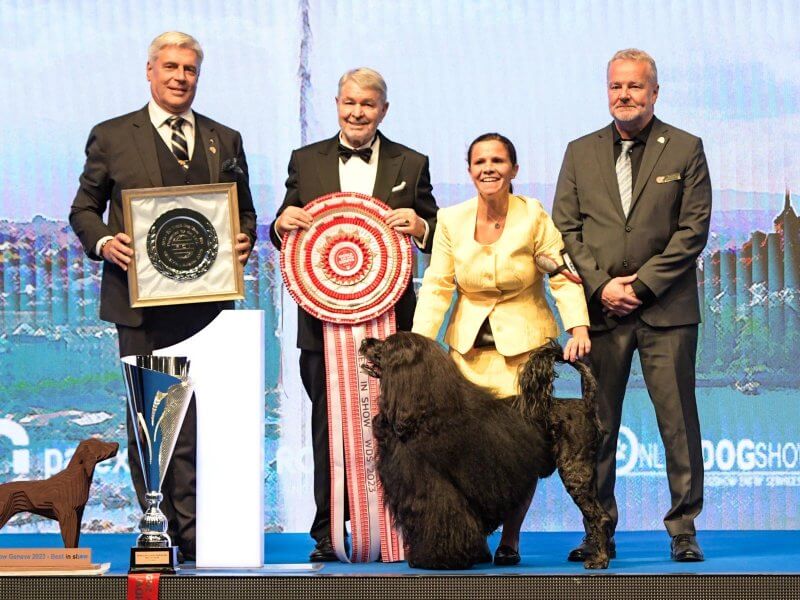
Home » 2023 GENEVA FCI World Dog Show

It promised to become a very hot World Dog Show (WDS), even hotter than the last one in Madrid. Europe suffered already with many heat waves, but for Switzerland, it promised to be a rare one. Geneva is enclosed by the Jura mountains of France in the west and the French Alps in the east, and faces a large and most beautiful lake in the north, the start of the River Rhone. Geneva’s most famous landmark is, without any doubt, its fountain, called le “Jet d’Eau” or the Jet. It is probably the highest fountain in the world, reaching about 140 meters high; a very impressive sight. Geneva is also known as one of the most expensive cities in the world, and indeed, regular pizza or a hamburger can easily cost €25 to €30. This, to give you an indication.
It was no surprise that more hotels, B&Bs, and camping sites were occupied in France, only 5 to 15 minutes away from the city, to avoid the high prices of the Geneva hotels. The show was held in the halls of Palexpo, bordering the Geneva airport and a crossing point of many highways to France, Italy, Germany, etc. Entry fees were high, notwithstanding the 13,406 dogs that were entered for the WDS, 4,999 for the Grand Prix of Genève on the day prior to the WDS, and another 3,320 for the various club shows held in the neighboring areas. I suppose that we can say that the Grand Prix and Club show entries were the same dogs as for the WDS. We can also say that 13,406 dogs is not too bad, but is still far from pre-COVID times.
For this show, 136 judges were invited from all over the world, and as the FCI big meetings were held in Genève prior to the show, most of them filled the carousel, a reproach regularly made for the FCI World and Section Shows. Being invited to judge at such a show is not easy if you are not part of the national organization of an FCI country. Would it be too expensive to invite a breed specialist instead of an all-rounder who is already there to attend the FCI General Assembly?
Of course, from the budget point of view, it certainly is, but these delegates need to come to the general assembly anyway. For such high entry fees, it should only be fair to invite a Breed or Group specialist. I am convinced that this would make a significant change in the number of entries. Too often the results are predictable, and this stops many exhibitors from coming. Of course, a specialist for every breed would be impossible, but for 50 percent of the breeds, it should be doable.
Dogs were entered from no fewer than 82 different countries. Italy was leading with 3,137 entries, France with 2,990, Switzerland with 1,965, and Germany with 1,885. These numbers are the entries of the WDS, Grand Prix of Geneva, and club shows all together. There were 463 dogs from the UK and 453 from Ukraine. Where Russia had always had a huge impact on the number of entries, only 163 managed to come over to compete. At the start of the war, Russian dogs were banned, but the reins are kept looser, it seems, and many Russian dogs are probably sold pro forma and registered in other countries to compete under the FCI flag. And of course, we need to keep in mind that not every Russian supports Putin’s regime.
Other extraordinary countries represented here are Uzbekistan, the Emirates, South Korea, Indonesia, Kyrgyzstan, Reunion, El Salvador, Panama, Tajikistan, New Zealand, and Australia (with 18 entries). The most popular breed used to be the Golden Retriever, but it was dethroned this time by the Pomeranian with 419 (compared to 387)! The French Bulldog followed with 359 entries. The Rhodesian Ridgeback was surprisingly fourth with 350 and the Whippet was fifth with 320. Again, these numbers are for all the shows together.
This time it was a real festival of very rare breeds, most of them not yet recognized by the FCI. From China, we could meet the Chongqin Dog and the Chuandong Dog, both looking like a mix of Bulldog and Shar-Pei, the first one with a Boxer-like face. The Laizou Hong or the Chinese Red Dog has the size of a German Shepherd Dog but has the typical Oriental-breeds look. The Taiwan Dog looks like the dogs we see too often caged in boxes for sale on market squares for consumption. Let us hope that this breed grows out to become a pet in the future so that dog meat will belong to the past. The Kintamani Bali Dog clearly belongs to the family of the Kishu from Japan and the Korean Jindo Dog. From Odessa in Ukraine, there were some Odis Dogs present. This is the first and only Ukrainian breed, a companion dog with the looks of a Polish Sheepdog. Another very old and interesting breed is the Kritikos Lagonikos or the Kreta Hound, a moderately large dog with sighthound looks mixed with hunting dog characteristics. There were other breeds too, but it would take too far to describe them all. I was very pleasantly surprised to meet people from Kazakhstan, in traditional clothing, presenting two blond Tazis. Tazis are very much like Salukis, only somewhat taller, with a broader chest, wider hipbones, and well-muscled with strong bones. It is not easy to see any difference with a Saluki unless you see them side by side. I used an Iranian Tazi for breeding my Salukis which is the reason why I recognized them. I am glad that they are seen as two different breeds now. Another breed is the Taigan, probably the breed that forms the transition from Saluki to Afghan Hound. The dog looks like a Saluki, but with much more feathering—even reaching over the thighs and chest. In my opinion, they are what they used to call, decades ago, the Plain Afghan Hound. You see, FCI World Shows can be very interesting and worth visiting.
The Swiss Kennel Club was founded in 1883, and exactly 10 years ago was host to the FCI European Championship Show. The organization, however, was not in its hands but in the hands of the Société Vaudoise de Cynologie. Switzerland has nine FCI-recognized breeds; there is the group of “Sennenhunden” like the famous Bernese Mountain Dog, the Great Swiss Mountain Dog, the Entlebucher Cattle Dog, and the Appenzeller. But much more famous is the Saint Bernard Dog, both the long- and the short-haired varieties. Furthermore, they have the Swiss Hound (Berner Laufhund) and the Small Swiss Hound, and they adopted the popular White Shepherd, imported from the US and Canada, and named it the Swiss White Shepherd. And recently, they’ve developed a new breed, a variety of the English Bulldog but missing all of its anomalies and which must have a straight topline, open nose, and a normal, broad chest. It is called the Continental Bulldog. Switzerland is very much concerned about dog welfare and has banned the cropping of ears and tails for already 20 years. Now they are trying to preserve the White Shepherd from the typical unnatural topline we see too often in German Shepherds, and they are bringing the Bulldog back to what it probably was more than a century ago.
It was relatively cool inside the halls, while outside it was between 39 and over 40°C [102-104°F], though due to the shade it was bearable, also for the dogs. To my knowledge, no serious problems with dogs were reported. The heat lasted three days and the halls slowly started to accumulate this heat so that it became hotter inside. Finally, on the fourth day, it started to rain. Along with the heat of the previous days, it became very humid inside, even with the temperature dropping several degrees. On Sunday it even rained plenty and there was hardly any sunshine outside. Some club shows that were held outside in the neighborhood were completely rained out. On the first day, the day of the Grand Prix de Genève, there were some minor problems with pushing at the entrance, probably because people had to wait too long in the hot sun with all their belongings and dogs. Every show of this size has its problems at the start, and this show was not an exception. The other days proved to be okay.
There are no longer printed catalogs. We are forced to get used to it! Fortunately, the Wi-Fi was okay. I cannot imagine a show like this if the Wi-Fi is not working properly. It will certainly be chaos, and Switzerland is known for its huge roaming tariffs, a few MBs can cost you easily €10 extra on your bill, same for calls and messages. Only two halls were rented, but they were huge and large enough to have the 80 judging rings. But they were rather narrow, especially for the large breeds. And because people tend to bring lots of things with them, like chairs, tables, etc., it was sometimes difficult to go around and not okay for safety in case of panic. I was there after the bomb attack in Argentina during the World Dog Show in 2005, and then you can understand the importance of safe passages towards the exits.
In the biggest hall was the entrance for the dogs and a number of rings. They were not lit very well compared to the rings in the second hall. In this hall were also the trade stands. I suppose they were very expensive too as was all the rest in Geneva. Only a few big pet food companies could afford a stand, plus a few others. The rest of the stands were free stands like the official photo booth, a promo stand for the premiere of a new educational game with Jean-Claude Vandamme as the main star (Dawn of the Chihuahuas), and the promo stands of the kennel clubs that organize the future FCI World and European Shows. At the end of that hall was the main ring, nice and not too large and arranged by P1 for the live-streaming and organization of the daily finals. The floor was covered with a blue carpet with the usual spots for the selected dogs and the large podium with a huge video wall behind, showing changing backgrounds except when the podium photos were taken. The team of P1 has become so experienced after several years that we know what we can expect. It also means that the timing is very strict and this resulted in reasonable hours to end the finals every evening, even for the BIS on Sunday. On one side of the main ring was a big tribune for the spectators and it was always pretty full. On the other side was the VIP area. There could have been some more entertainment, but we don’t see that any longer, which is a pity. For this show there were two Alpenhorn blowers and two men singing very high and very melodious without words. It wasn’t yodeling, but it sounded enchantingly beautiful. Folkloristic dancing like we often saw in Eastern European countries was always a treat and a welcome distraction. But why not dog dancing or other dog acts? It is, after all, a “dog” show!
Every evening we had finals for the Groups of that day in Minor Puppies, Puppies, Junior Dogs, Veterans, Couples Class, and Breeders Groups, plus, of course, the winners of each Group. These were expected to come back on Sunday for the Best in Show competition. There was also a Junior Handling competition every day.
This World Dog Show was well-organized but very expensive. This, however, did not keep the exhibitors away. After all, there is only one World Championship every year! Switzerland had to count on foreign ring stewards and people to help in the organization for a show of this size. Foreign ring stewards were welcome and received hotel accommodations, compensation for travel expenses, and 100 Swiss Francs (around 100 EURO) each day. With two stewards per ring and 80 rings all together every day, it counts! All this makes it a big challenge to determine the costs and defines the price for entering a dog. This was also an interesting show because of its international appearance and collection of rare and new breeds.
Second in the World Dog Show was a dog from the US, the English Setter, Quantum Clos Erasmus Spirit World, owned by Tracy Wiles, and the Third Place went to Canada, to the Affenpinscher, Kick Em Kenny V Tani Kazari, owned by Yvonne Savard. The Best in Show winner of the World Dog Show, was the one and same dog that won the Grand Prix de Genève on Wednesday, a Portuguese Water Dog, Aquafortis Robel The One, owned by Runi Kristiansen from Norway. The handler from Portugal could not believe her ears when she was called into the ring as the ultimate winner. Her son and daughter were also there and, I think, I never saw so many tears of joy! Who could ever think that the same dog could win both shows in a row? They will certainly never forget this thrilling moment!
The next World Dog Show will be held in Zagreb, the capital of Croatia, while the FCI European Section Show 2024 will be in Celje in Slovenia, not more than 185 km apart. Both countries can be very hot too, but I hope it will be bearable for everyone and for the dogs in the first place.
